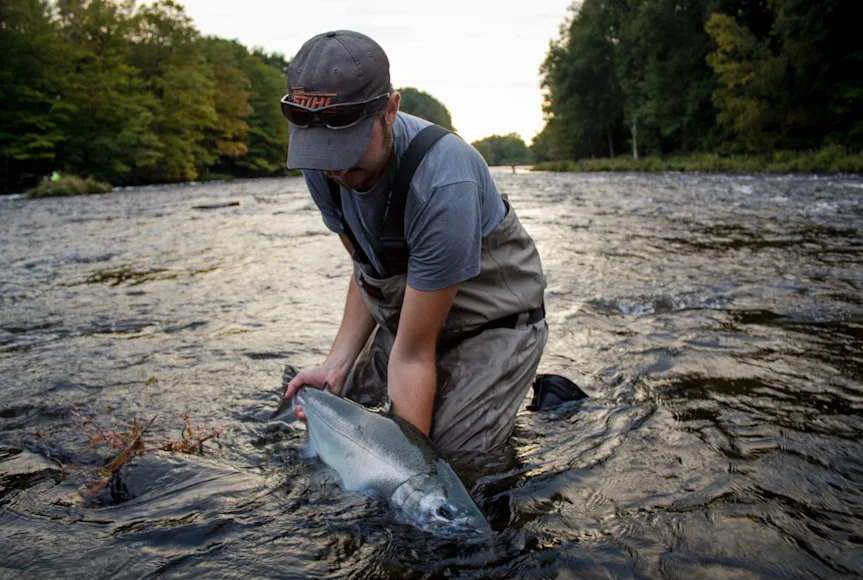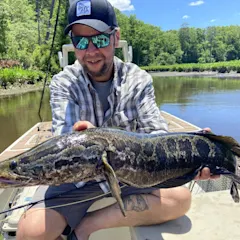The most successful time to fish usually coincides within a window of opportunity. We may not even realize what’s creating the window or why it’s open when we’re catching fish after fish, but you can rest assured that something in the environment is making those fish chew. It could be as simple as a bump in water height from the day before or as complex as the wind being just strong enough to blow grasshoppers into the water in the exact stretch of river you’re fishing. On the flip side, when we’re struggling to get even a little tap out of a fish, there’s a reason why the window is closed.
Good fishing—whether you’re a saltwater angler wanting to go redfish fishing or a beginner fresh-water angler who wants to learn how to catch crappie—ultimately boils down to good timing. In many cases, we can’t predict the catalyst that will make the bite fire. We simply get lucky and show up at the right time. There are, however, certain indicators we can track and monitor to put the odds in our favor. If you’re looking to nail down the best time to fish, this breakdown will help—though I urge you to take the final piece of timing advice to heart.
Table of Contents: The Best Time to Fish
Fish When the Light Is Low
Fish When the Weather Is Stable—or About to Destabilize
Fish When the Moon Is Favorite
Fish Whenever You Can
FAQs

Fish When the Light Is Low
It’s common knowledge that the best time to fish is early. This explains why devout anglers routinely get up before dawn to be on the water at first light. But have you ever thought about why? Sure, there’s an advantage to beating someone who slept in to a good spot, or enjoying the lake or river in the quiet hours before all the jet skiers, water skiers, rafters, and tubers show up. But the main reason fishermen are early to rise is because they want to fish when the light is low. There’s a reason why the hours right before sunrise and sunset are called the “magic hours.” Fish are often at their most aggressive and least cautious during these windows.
All fish are sensitive to sunlight to some degree. Walleyes, for example, are far more active in stained water and during the dark of night. Even fish like trout and bass that don’t really mind a sunny day tend to get more cautious at noon under a bluebird sky. It’s not that they won’t eat—it’s just that they may not move as far for a meal. Light makes it easier for them to really study their food; makes them more paranoid about being attacked by birds; and more likely to see you when it’s bright and sunny. Sunlight can be such a huge factor in productivity that during the summer months, when lakes and rivers tend to be at their lowest and clearest of the season, I won’t usually fish much past 9 a.m. If I want to fish later, I’ll start an hour before dark and fish past sundown. And if you’ve ever heard a fisherman claim cloudy days are the best days to fish, there’s truth to that because cloud cover keeps the light lower all day.
Daily low light periods also happen to coincide with temperature settings that make fish more comfortable throughout the season. In the heat of summer, the water will be coolest just before dawn. In fall and winter, it’s usually a degree or two warmer just before dark, having soaked up any available rays and absorbed ambient heat from wood or rocks protruding from the surface.
Fish When the Weather is Stable (Or Just About to Destabilize)
Are fish more active when the barometric pressure is low or high? Do fish really bite better in the rain? These are questions fishermen have been debating forever, but if you talk to serious anglers, most will agree that one set of weather conditions isn’t necessarily better than another. What fish really crave is stability.
Whether it’s raining for a week or sunny for a week, the fish will adapt to those stable conditions and bite. What they don’t like is when it’s pouring and chilly one day, windy and sunny the next, roasting hot with thunderstorms the day after that, and cool again the following day. The more rapidly weather conditions change, the more difficult it can be to catch fish because they’re not settling into a specific pattern or location. Changing weather often has them in flux, so you should always monitor the long-term forecast a few days before and after the day you plan to fish. You want to see similar wind, sky, and temperature conditions, but if it appears a big change is coming, all hope is not lost.
A rapid weather change can also be an incredible bite trigger, especially in the summer months. If it’s been 90-plus degrees and sticky for a couple days and suddenly the weatherman is calling for a storm front, you can expect action hours before to right when the storm hits. Naturally you have to use your judgment and fish safely, but fish can feel the changing pressure. They know a shake-up is coming and will often go on a feeding tear leading up to the change. Conversely, the days following that major shakeup can be extremely hard to fish because the pressure, wind, and temperatures will be all over the place until things stabilize again…at which time the fishing will perk up.

Fish When the Moon is Favorable
Of all the natural factors that dictate fish aggression and willingness to feed, I believe it’s fair to say that the moon phase is overlooked by most anglers. And I understand this because it’s easy to say, “Who cares about the moon? I’m not fishing at night.” The reality, of course, is that the moon affects water and fish 24-7, and while I don’t believe it’s the most critical factor in deciding the best time to fish, it’s worth having a basic understanding of how it can alter the bite.
Muskies anglers are notorious for tracking moon phases, putting loads of stock in these famously finicky predators opening their mouths at specific times during specific phases. How the moon affects fish is complex, but in a nutshell, the moon shifts gravitational pull on the Earth, which does things like create tides in saltwater. Though you and I can’t feel the difference in the moon’s pull in any given phase, fish can. Roughly every six hours, there is a major or minor moon phase. To break them down simply, a major phase occurs when the moon aligns with the Poles directly overhead or underfoot. Minor phases occur when the moon is halfway between those points, sort of aligned with the equator. Most fishermen won’t give these positions any thought, but I’ve been out with serious striped bass and muskie guys who track the phases and insisted we’d get bites or at least see fish just before the peak of the next major or minor phase—and we did.
It’s also worth considering the brightness of the moon, which can help or hurt you depending on the scenario and what you’re targeting. The new moon is when there’s no moon visible in the sky, making the night extra black. This phase is often preferred by nighttime walleye, striped bass, snook, and muskie anglers because the darker it is the harder it is for the fish to see their prey, making it more likely they’ll make a mistake and take a shot at a lure or bait featuring a nice sharp hook. The full moon, on the other hand, can make it so bright that fish feed all night long. By the time you show up in the morning they’re fat and happy and you’re left wondering why nothing wants to eat.
The Best Time to Fish Is When You Can
Every time I write or read an article about the best time to fish, what I really want to say is that the best time is whenever your schedule allows you to be on the water. Tracking weather, being there at low light, and monitoring the moon phases are all useful for helping you catch more fish when you do get out there, but I’d be lying if I said I let these factors dictate when I fish all the time. It’s great when favorable light or conditions coincide with an outing, but even when nothing seems right, I still go fishing—because tomorrow I have a meeting, and the next day is the ballet recital, and the day after that we leave for Disney World. Nothing gets in the way of fishing faster than life, and if there’s one thing I’ve learned over the years it’s this: JUST. GO. FISHING. No matter the time or conditions, if you’re on the water as much as possible, the stars will align on some of those trips, and you will catch fish.
FAQs
Q: What time of the day are fish most active?
Fish are most aggressive and least cautious during low light hours. This means dawn and dusk are the best times to fish and the reason so many anglers get up well before sunrise.
Q: Is it better to fish before, during, or after rain?
Fish like stable conditions and constant fluctuation in weather can turn off a bite. Once conditions stabilize, fish will adjust and then start biting again. That said, a rapid weather shift can also trigger a bite since fish can sense the changing pressure. If you see a storm coming after a hot spell, be sure to hit the water right before it comes. Chances are the fish will be biting.
Q: What time do most fish eat?
Fish feed the most around sunrise and sunset. The water conditions at these times are usually optimal for fish movement. Fish are aggressive and more willing to take a lure or bait during these low light hours.


